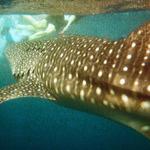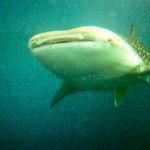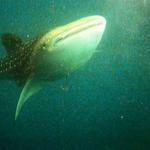© 2011 Sabrina Swenson. All Rights Reserved.
Djibouti and Somalia
January, 2014
When I told people I was going to Djibouti it was usually met with a blank stare. Ja where, they would ask. Where's that?? Djibouti (pronounced Ja boo tee) is a tiny country in the Horn of Africa surrounded by Eritrea, Ethiopia, Somalia and is across the Bab-el-Mandeb strait from Yemen. It's next to the busiest shipping lanes controlling access to the Red Sea and Indian Ocean. As a key refueling center, it is the main port for imports and exports from neighboring Ethiopia. It's also home to various foreign military bases.
I arrived into dusty, tiny Djibouti and caught a taxi into town. Not only is the country named Djibouti but so is the capital. And so, I arrived into Djibouti, Djibouti by road. I had the taxi drop me off in the middle of town and quickly found a hotel. After checking in and leaving my things I went out to explore. I didn't see any other tourists as I wandered the streets, markets and shops of this sleepy town. I eventually found the office I was looking for and went in to sign up to snorkel with the whale sharks! I wanted to snorkel the following day but was told it probably wouldn't be possible as they had a private group of twenty-eight people. A quick phone call was made and I was informed I was allowed to join the group. When I headed down to the pier the following morning and boarded the boat, shortly thereafter, twenty-eight US Navy medical personnel arrived. As a key port, various foreign military have bases in Djibouti including Camp Lemonnier, a US base. I took off with the Americans for about two hours before reaching the area where the whale sharks are known to congregate. Since they spend a large amount of time near the surface it is better to snorkel with them instead of diving. Once anchored, half of us boarded skiffs (small boats) and went another ten minutes in search of the sharks. Since they have two fins and are usually near the surface they're fairly easy to find. We would wait to spot them and then jump in. I jumped in first and looked around disappointed to not see anything other than a bright red crab by my face which originally startled me. As I slowly swam around I was even more startled to see a huge whale shark right behind me. Obviously, underwater you don't have the luxury of hearing anything sneak up on you! As I noticed all the other people swimming closer I, already way too close, was trying to swim away from it. We were told in our briefing that we should not touch the whale shark and to especially stay fifteen feet away from the tail which could do serious damage it the shark decided to switch it. When I finally reached a safe distance I turned and enjoyed the huge fish. Whale sharks can grow up to forty feet and as filter feeders, they feed mainly on plankton (hence the reason it's safe for humans to snorkel with them!) The mouth alone, of a whale shark, is almost five feet across. The sharks we saw would usually just hang out for a while before diving down at which point we would board the skiff and again take off to find another. After about an hour and several whale sharks later, we sailed back to the main boat and then the other half of the group went off to see them. We eventually sailed back to Djibouti and passed the French Foreign Legion base on our way.
The following day I was up bright and early as I was picked up by a land cruiser to head several hours away to Lac Abbe. I first saw a picture of Lac Abbe a few years back and immediately said "I have to go there"! I like to see unusual places and Lac Abbe did not disappoint! It lies at the Afar Triple Junction, the central meeting place for the three pieces of the Earth's crust. Here three pieces of Earth's crust are each pulling away from this central point. It's a strange, eerie, moon like lunar landscape. It has chimneys of limestone as high as 164 feet, from which steam vents, dotted across the terrain that make it look like another planet. Lac Abbe is several hours from Djibouti city over some seriously rough roads. On most of the journey there were no roads at all, just a dusty trail. With me were two Swedish girls from the Swedish embassy in next door Ethiopia. The three of us and our driver bounced our way to Lac Abbe in the blazing sun and a perpetual cloud of dust. On the way we saw numerous dust devils swirling high into the sky. When close enough, we saw the first sights of desolate Lac Abbe in the distance and stopped for some photos It really does look like another planet. As we pulled up to the first mound of limestone we climbed out and looked like ants next to it's huge size. Back in the vehicle, we bobbed and weaved through the piles of limestone making our way up a small hill. Once we reached the top of the hill I saw the coolest campsite with numerous huts and a campfire. I was delighted to find out that this is where we would be camping for the night. I selected a hut which was comprised of a metal frame which curved to make a round hut which looked basically like an igloo. Over the metal frame was a cover which appeared to be made of woven reed of some sort. It was complete with a "door" which was basically a flap you pulled down once inside. In the hut was a military grade cot with a small mattress which was surprisingly comfortable. There was also a mosquito net hanging over the cot. I unpacked and then wandered around the area. Next to it was a building for cooking and a couple tables with plastic chairs. There was also a long building with numerous doors which I would find out was a row of real toilets and showers. Not too bad considering some places I have camped. More visitors arrived and we all watched as the sun set over this truly unique, surreal backdrop. As the sun settled the sky turned a variety of colors including a magnificent purple. Once it was dark we went back to the dinning area for a large dinner cooked over the fire. We retired early and then were up before the crack of dawn for the sunrise. The Swedish girls and I piled in the land cruiser and drove a bit to a different view of Lac Abbe. After many more pictures we returned to the campsite for breakfast. Once packed up we were once again on our way weaving around the limestone piles and continued on our way across the country to or next destination; Lac Assal.
Lac Assal is a saline lake which lies 509 feet below sea level. It's the third lowest land depression on Earth after the Dead Sea and the Sea of Galilee. The lake consists of two distant parts; one is the crystallized salt surface and the other is the high saline brine area. The result is a stunning sight as Lac Assal is a magnificent blue/green and white from the salt. We arrived and set off on foot to the salt surface. The bright white surface is rock hard. The area was almost blinding as the bright sun reflected off the snow white surface. A dip in the water makes you bob like a cork. It would take some serious effort to drown in this Lake! Once we had our fill we eventually returned to the land cruiser and headed back to Djibouti City. I said goodbye to my travel partners, the Swedish girls and was returned to my hotel. The next few days I spent simply hanging out in Djibouti City but in a town with not much to see, my highlight was usually having morning coffee at the cafe with the local men (local women do not sit with the men). Again, foreign women, if appropriately dressed, are generally free to do things local women cannot.
After studying the map and realizing how close Somalia is to Djibouti, I had decided before my trip that I might as well hop over the boarder to Somalia, having never been there before. And so, although you can fly to Somalia, I decided to go local and take ground transport. Little did I know the hellish ride I was about to endure! I found my way to where the local transport vehicles congregate in Djibouti City and found the one that was headed for Somalia. It was an old Land Cruiser which had definitely seen better days. The row of seats inside had been ripped out and replaced with way too many rows in such a small area. Using local transport like this you simply have to wait around until every seat is sold before you depart. As such, I milled around the vehicle for about and hour and a half until every seat was sold and we were ready to go. I took my place in the second row right behind the front seat on the passenger side and immediately realized being far taller then everyone else, as such, my knees were immediately jammed into the seat in front of me. I then was surprised when not only two but three other women jammed in next to me (in a row only built for three). We were smashed in with little to no room to spare. I looked back and the two rows behind me were equally tight. I thought "this will be a tight ride but how long could it take to go 150 miles?" Little did I know! We set off in the late afternoon and I fully expected to spend the night in a hotel in Somalia. After only a short time we reached the border and had to exit the vehicle to clear the Djibouti and then the Somalia customs and immigration. We were fairly quick, by African standards, but once in Somalia we waited for hours for the land cruiser to be cleared. In a long line of vehicles I wondered why so many people wanted to go IN to Somalia instead of out. The line moved at a snails pace as each vehicle was brought in one at a time and thoroughly unpacked of it's cargo, which was mounted on top of the vehicle thrown into a huge pile and covered with a tarp and bungee cords. Each vehicle was unpacked, thoroughly searched and repacked. This process with a large line of vehicles took hours! We; the occupants of the vehicle, had nothing to do other than to stand around in the now dark, middle of nowhere and wait for our vehicle. As the sun went down the temperature dipped and was now quite cold. I always travel with a fleece, a fleece hat and a large scarf and put these all on. When our vehicle was finally cleared we hopped in and drove into the night. With four of the vehicles windows wide open since we departed I asked if we could now shut them as it was freezing in the desert night air. Imagine my surprise when I was informed they were not rolled down but, rather, all broke out and completely missing! I just shook my head and was amazed that this fact didn't seem to bother anyone else in the vehicle. I put my head down on the seat in front of me and put the scarf over my head and thought when will this hell end! Shortly thereafter, as if it weren't already bad enough, the vehicle broke down. Apparently, I would find out later, the radiator had a leak and as such, we ended up stopping seventeen times during our journey to fill it back up! It wasn't until shortly before our final destination, Hargeisa, that we would find someone who could fix it. Every time we stopped we would have nothing to do since we were truly in a no-mans-land area. There was nothing around for miles and miles and so we would just sit and wait until it was temporarily fixed and we could be off again. This hellish ride of 150 miles took 20 hours and 5 minutes! Upon pulling into Hargeisa, Somalia the following afternoon, I couldn't wait to get out of the vehicle and never wanted to take local transport again!
Once my bag was retrieved from the roof I found my way to a hotel and took a much needed hot shower. After a nap, since there was no sleep the night before, I was off around Hargeisa to have a look at Somali life. I should point out I was in the Somaliland region of Somalia which is located in the North, West part of the country. Somaliland was once known as the British Somaliland Protectorate and after gaining independence from the UK in 1960, joined the rest of Somalia. By 1988, relations between the inhabitants of Somaliland and the rest of Somalia had disintegrated beyond repair, a series of massacres ordered by former Somali dictator Mohammed Siad Barre sparked a vicious civil war. When the Somali government finally collapsed in 1991, the local government of Somaliland declared itself independent from the rest of Somalia, seeking self-determination as the Republic of Somaliland however Somaliland's self proclaimed independence remains unrecognized today by any country or international organization. And so, it is simply Somalia.
I was warmly greeted as I wandered the streets and when people asked where I was from upon telling them I was American, I received a kind hello and welcome. I took a look at the Somali Air Force MIG jet fighter that is situated in the center of town. It crashed during an aerial bombardment of the city and now serves as a reminder of the heavy bombardment the city endured in 1988. It symbolizes the long struggle that Somalilanders have faced. Other than the MIG, there weren't a lot of "sights" to be seen in Hargeisa but it was still interesting to have a look around the city at everyday life. The Somali women where completely covered from head to tow with brightly covered fabrics. Money changers sat in the streets with their huge piles of cash sitting out in the open. Apparently there is no problem with theft here. Men ran their stands in the market displaying their goods and a donkey carrying a tank of water on it's back served to clean the streets although since most were made of dirt I didn't exactly understand this logic. Life is Hargeisa is slow and dusty, but it's people are friendly.
The following day I got a taxi, with obligatory armed guard, to Laas Gaal where some of the earliest known cave painting in the Horn of Africa from the Neolithic period are found. The paintings are amazingly well preserved although not surprising since, as you can imagine, there aren't a whole lot of tourists in Somalia to ruin the site. The rock art is estimated to date back to somewhere between 9,000-3,000 BC! It depicted men, cows, dogs, etc. and was painted in vibrant reds and oranges. If and/or when Somaliland becomes recognized internationally, I have no doubt this will be a UNESCO world heritage site. We made the drive back to Hargeisa and on the way the driver stopped at a large barrel sitting under a make shift cover, by the side of the road. A young woman appeared and dipped from the barrel which contained camel milk. My driver downed the milk and we were once again off. We passed herds of camels and numerous houses in the countryside which were actually very rudimentary huts apparently made of branches and material. The kids would run out to the vehicle with big smiles and perfectly white teeth waving fervently as we passed. I arrived back in Hargeisa and after another couple days of taking in the town I headed to the airport for my flight home via Ethiopia.
Although Djibouti and Somalia are not exactly on a travelers list for best places to travel, I did find both to be interesting in their own way. Snorkeling with the whale sharks and the lake's in Djibouti were definitely the highlight. While getting a first hand look at life in Somalia was definitely a unique experience. I hope Somaliland will someday get the independence from the rest of Somalia that they so desperately want.



